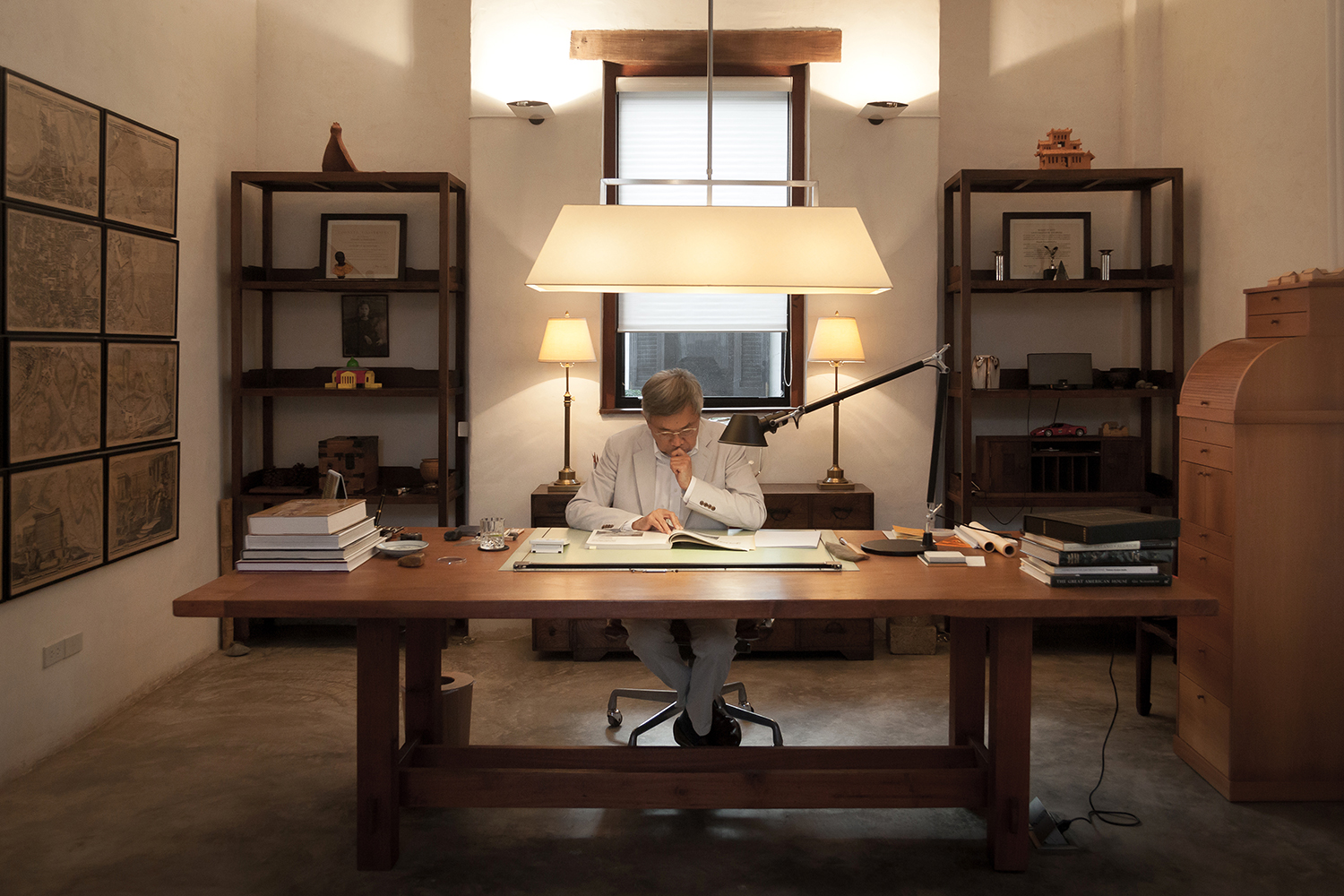AT THE AGE OF 75, THE THAI TRADITIONALIST ARCHITECT ONG-ARD SATRABHANDHU REFLECTS UPON HIS VIEWS TOWARDS THE PAST AND THE IMPORTANCE OF HISTORY
INTERVIEW: PAPHOP KERDSUP / WICHIT HORYINGSAWAD
PORTRAIT: KETSIREE WONGWAN
PHOTO COURTESY OF ONG-ARD ARCHITECTS
(Scroll down for English)
art4d: สมมติว่า context เป็นอย่างหนึ่ง คุณมีวิธีในการทำงานสถาปัตยกรรมบน context นั้นอย่างไร
Ong-ard Satrabhandhu: context ของบ้านเรามันไม่แน่นอนนะจริงๆ แล้ว คืออย่างเวลาผมทำผมก็ต้องหันหลังให้กับ context นั้น เพื่อให้พอเข้ามาในพื้นที่แล้วมันกลายเป็นโลกที่ผมสร้างเอง เพราะมันเป็นสิ่งเดียวที่ผมควบคุมได้ แต่รอบๆ นี่ผมควบคุมมันไม่ได้เลย ก็เลยต้องหันหลังให้ ซึ่งก็ไม่ใช่ว่าดีนะ แต่มันเป็นวิธีเดียวที่เราจะสามารถสร้างความสงบได้ ที่ต้องใช้วิธีนี้เพราะมันไม่มีทางอื่น context มันเปลี่ยนไปเรื่อยๆ เทศบัญญัติที่ถูกต้องที่จะให้เมืองมันเป็นระเบียบได้มันต้องไม่ใช่แบบที่เป็นอยู่ ผมคิดว่าเวลาสร้างถนนแล้วตึกต้องอยู่แนวเดียวกัน ไม่ใช่ว่าเราจะ set back ยังไงก็ได้ คือเมืองที่สวยมันเกิดจากถนนที่เลี้ยวไปมาแล้วมีตึกที่มันเป็นระเบียบเรียบร้อย ยกตัวอย่างงานผมที่เยาวราช ถ้าเราปรับปรุงตึกไม่เป็นไร แต่ถ้าเรารื้อตึกสร้างใหม่มันต้องถอยร่นไปตั้งไม่รู้กี่เมตร ซึ่งมันไม่ควรเลย เพราะระยะเดิมมันทำให้เกิดความเป็นระเบียบของถนน เวลานี้ตึกหรือบ้านต่างๆ นี่ถอยกันไปเลย คือคนที่ทำลายเมืองจริงๆ ก็คือเทศบัญญัติกับสถาปนิก ซึ่งสถาปนิกนี่แหละตัวดี
art4d: แล้วถ้ามีโจทย์หนึ่งที่ตัวงานมันอยู่ท่ามกลางธรรมชาติ คุณเลือกที่จะจัดการกับมันยังไง จะ enclose หันหลังให้มัน แล้วก็ควบคุม context ด้วยการสร้างมันขึ้นมาเองหรือไม่
OS: อย่างบ้านที่แม่ริมผมก็เปิดนะ เพราะว่ามัน enclose ด้วยภูเขาที่อยู่ไกลลิบเลย คือผมเปิด แต่ว่ามันก็ต้องมี sense ของเอาท์ดอร์สเปซที่มัน connect กับตัวบ้าน แล้วที่สำคัญคือตึกมันต้องมีแกน
art4d: จากที่คุณได้เห็นทั้งงานโบราณของทางฝั่งตะวันตกและงานของจีน คิดว่ามันมีข้อสรุปหรือรากฐานบางอย่างร่วมกันอยู่ในทุกวัฒนธรรมหรือเปล่าในความคิดของคุณ
OS: มันมีร่วมกัน คือผมว่าจริงๆ ที่สำคัญสำหรับอาคารนั้นคือ ขนาดของ indoor กับขนาด outdoor อันนี้มันเป็น basic ที่สำคัญ สเปซภายนอกมันต้องไหล ไม่ไหลมันไม่เป็นสเปซ แล้วมันก็ต้อง enclose ด้วยอาคาร ฉะนั้นมันอยู่ใน 4 ข้อของจีนเลย enclosure, hierarchy, axiality แล้วก็ symmetry
art4d: เท่าที่สังเกตมาตลอด พวก proportion ขององค์ประกอบต่างๆ มันมีความต่างกันบ้างไหม
OS: จริงๆ มันมีเหมือนกัน อย่างผมจะชอบห้องที่มัน…อย่างสมมติห้องที่เป็นอินทีเรียสเปซ พอเราใส่เสาลอยไปเข้าไปข้างใน มันก็คือโบสถ์ฝรั่ง คือมันทำให้เกิดสเปซย่อยขึ้นข้างใน นี่เป็นสิ่งที่ฝรั่งกับจีนมีร่วมกัน หรืออย่างเวลาที่ Palladio เขาทำห้องแล้วใส่เสาลอยไปเข้า มันผิดกับห้องเรียบๆ ที่ไม่มีเสามาก คือมันมีเสน่ห์แบบที่บอกไม่ถูกเลย มันสวย แต่มันไม่ใช่แค่นี้มันต้องขึ้นมา 3 มิติแล้วสวยด้วย คือสิ่งที่คนจะประทับใจ จะชอบหรือจะเกลียด จะสนใจหรือจะเบื่อไม่อยากดู มันคือคุณภาพของที่ว่าง (quality of space) ไม่ใช่รูปทรง เพราะมันทำให้เกิดไดนามิค ดูอย่างแปลนของ Barcelona Pavilion สิ มันมีเส้นไม่กี่เส้นเอง แต่ไปดูของจริงนี่ผมใจเต้นเลยนะว่า ทำไม movement มันแรงอย่างนี้ อย่างเราคิดว่ามันต้องเข้าตรงๆ ทางนี้ แต่ไม่ใช่ๆ มันต้องเข้าทางนี้แทน อันนี้คือ Architectural Promenade สิ่งนี้คือสิ่งที่นักศึกษาควรต้องถูกบอกให้มอง ไม่ใช่ไปดูฟอร์มทาง abstract เท่านั้น
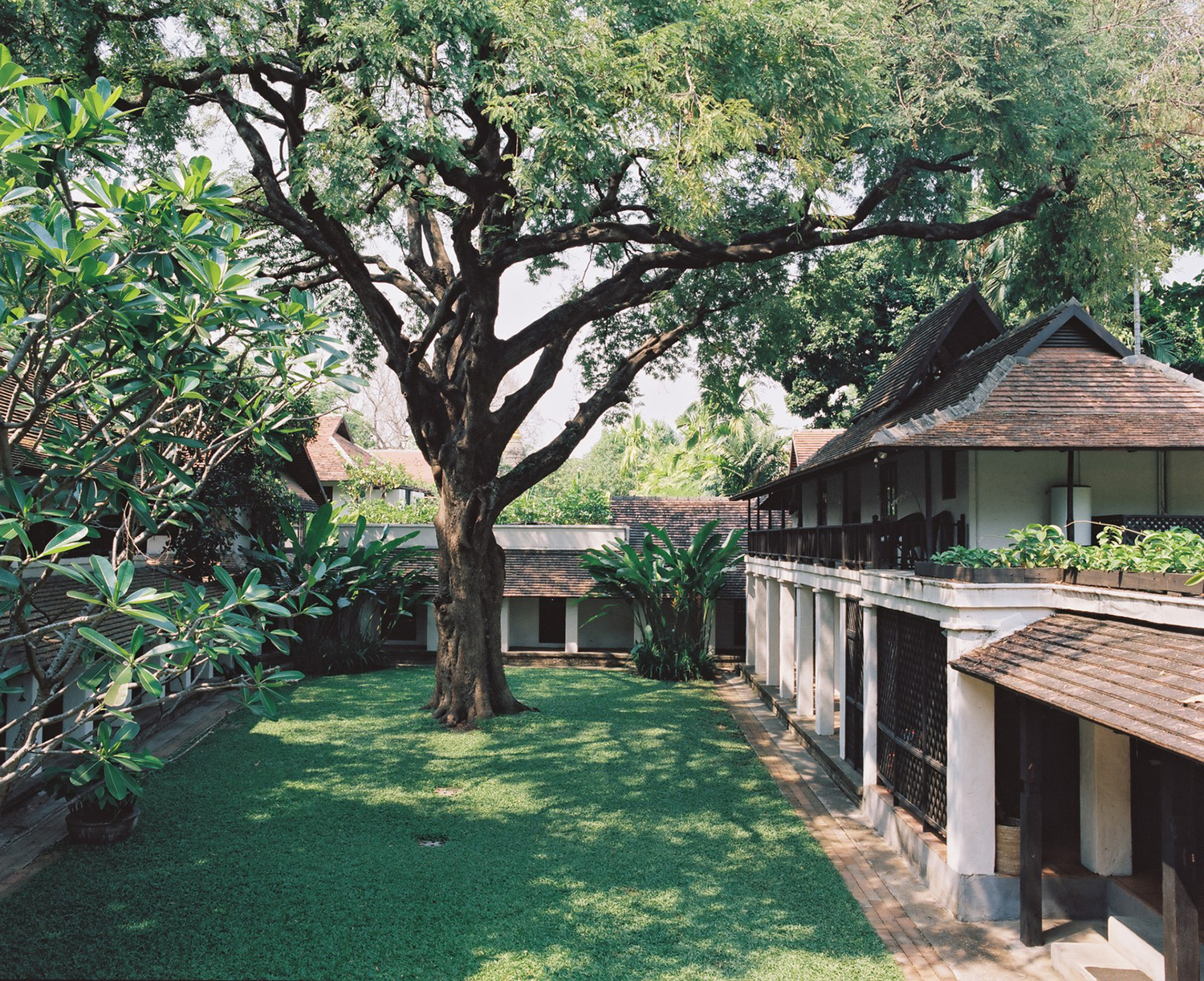
โรงแรมแทมมาริน วิลเลจ ผลงานสถาปัตยกรรมชิ้นแรกขององอาจที่มีการนำภาษาสถาปัตยกรรมแบบ traditional มาใช้ และยังเป็นผลงานชิ้นแรกของเขาในจังหวัดเชียงใหม่ด้วย | TAMARIND VILLAGE HOTEL IS THE VERY FIRST PROJECT BUILT IN CHIANG MAI BY SATRABHANDHU AND THE FIRST PROJECT WHERE HE EMPLOYED THE LANGUAGE OF TRADITIONAL ARCHITECTURE
art4d: พูดถึงเชียงใหม่ คุณเริ่มมีงานที่นี่งานแรกตอนปี 1999 ซึ่งคือโรงแรมแทมมาริน วิลเลจ ทำไมในเวลานั้นจึงตัดสินใจย้ายจากกรุงเทพฯ มาอยู่ที่นี่
OS: ผมย้ายมาตอนปี 2000 มันมาโดยบังเอิญ คือทำที่นี่แล้วเรารู้สึกว่าต้องมาดู ต้องอยู่ที่ไซต์ทั้งวันเลย กลายเป็นว่าผมมาเดือนละ 2 หน อยู่ครั้งละ 2-3 วัน แต่มีสถาปนิกที่อยู่ประจำก็ต้องพูดกันทุกวัน แล้วที่ต้องอยู่ที่ไซต์ตลอดเวลาเพราะผมไม่มีผังชัดเจน มันมีผังคร่าวๆ มากๆ ก็เลยต้องดูหน้างานตลอด จนตึกสร้างเสร็จแล้วยังไม่รู้ว่าจะ connect อะไรยังไง คือผมจะบอกช่างวันต่อวัน แล้วข้อดีอีกอย่างหนึ่งคือมันทำให้งานดูเป็นธรรมชาติเหมือนชาวบ้านสร้าง แต่มันก็มีปัญหาคือมีหัวหน้าช่างคนเดียวที่เป็นงาน ที่เหลือทั้งหมดทำงานไม่เป็น ถ้าคนที่สั่งงานป่วยเมื่อไหร่ งานวันนั้นต้องหยุด ตัวผมเองก็สั่งไม่ได้เพราะไม่มีความรู้ นี่แหล่ะข้อเสียของผมคือผมไม่มีความรู้ด้านก่อสร้าง อย่างตอนไป Vicenza เขาบอกกันว่าหัวเสาที่ Palladio แกะเองจะมีความอ่อนช้อยกว่าอันอื่น ผมทำอะไรไม่ได้เลย แล้วจริงๆ ถ้าเอาตามที่ Vitruvius พูดนะ ที่ว่าสถาปนิกต้องทำสิ่งต่างๆ เหล่านี้เป็นด้วยนี่ ผมคิดว่ามันจะไม่มีสถาปนิกเลยในโลกนี้ เพราะไม่มีใครที่ qualified คือสำหรับผมทุกอย่างมันมีต้นแบบ เพราะฉะนั้นเวลาถ้าใครมาดูงานผมก็จะบอกว่าอันนี้ต้นแบบมันมาจากไหน อยากให้เขารู้ ผมไม่เคยคิดอะไร ตั้งแต่เกิดมายังไม่เคยคิดอะไรเอง คือคนที่คิดเองได้นี่ต้องมีความสามารถสูง แค่ทำงานไม่ให้คนด่าก็ลำบากแล้ว ไม่ใช่ด่าสิ รังเกียจที่จะเข้ามา
art4d: เกือบ 20 ปีที่ผ่านมา ตั้งแต่ที่คุณย้ายมาอยู่ที่เชียงใหม่ คิดว่าเชียงใหม่เปลี่ยนไปมากน้อยแค่ไหน คือเหมือนในแง่หนึ่งการพัฒนามันก็เป็นการเพิ่มโอกาสให้กับเมือง แต่อีกมุมหนึ่ง gentrification ที่มาพร้อมกับการพัฒนามันก็ทำลายเมืองไปอีกทางด้วยหรือเปล่า
OS: เพราะทุกคนกระหายเงินไงมันเลยเปลี่ยนไปเยอะ ไม่มีใครทำอะไรเพื่อความสวย แต่ทำเพื่อจะทำเงิน หรือไม่ก็ทำเพื่อให้ฉันดูเด่นอะไรอย่างนั้นข้อคิดไม่มี มันเลยกลายเป็นการทำลายเมือง ซึ่งนี่มันเป็นเรื่องจริงนะ อย่างตอนนี้ที่เรานิยมใช้โทรศัพท์มือถือกัน สมัยก่อนวัฒนธรรมมันเป็นอีกแบบเลยคือด้านศิลปะ ด้านความงาม ทุกวันนี้เมืองมันก็เจริญ แต่ไปเจริญด้านอื่น
art4d: โรงแรมแทมมาริน วิลเลจ นี่เป็นโปรเจ็คต์แรกใช่ไหม ที่คุณดึงเอาองค์ประกอบที่มันเป็น traditional มาใช้
OS: เป็นโปรเจ็คต์แรกของผม แต่ก่อนแถวคูเมืองจะไม่มีโรงแรม เพราะคนคิดว่าถ้าจะทำโรงแรมที่เชียงใหม่ต้องเป็นรีสอร์ต ต้องอยู่นอกเมืองอยู่กับควาย อีกอย่างคือผมเห็นสิ่งที่จะเป็นลักษณะพิเศษให้โรงแรม ในยุโรปนี่มันจะมีแค่ช่องเล็กๆ เข้าไปแล้วมีสเปซสวยอยู่ข้างใน คือผมมองว่าคนที่ทำค้าขายแล้วเขาเปิดข้างหน้าให้จอดรถ มันเหมือนคนแก้ผ้า ผมว่ามันอนาจารมากเลย อย่างโครงการตรงหัวถนนนิมมานฯ โครงการรินคำ เจ้าของเขาบอกว่าอยากให้ถอยตึกเข้าไป แล้วให้รถจอดด้านหน้า ผมบอกว่าผมไม่เห็นด้วย และผมจะเสนอคอนเซ็ปต์ไป ถ้าไม่เห็นด้วยก็จ่ายค่าแบบมาเท่านี้ ถ้าเห็นด้วยผมก็ทำต่อ เพราะสิ่งที่ผมจะทำไม่ใช่อย่างที่เจ้าของงานพูด ปรากฏว่าเจ้าของชอบคอนเซ็ปต์ที่ผมเสนอให้มี public space สำหรับคนโดยไม่มีรถยนต์ซ่อนอยู่ภายใน ด้านถนนเราจะทำอาคารให้อยู่แนวเดียวกับถนนตลอด โดยมีจุดที่มองเห็นพื้นที่ภายในได้จากถนน
art4d: ตลอดการทำงานที่ผ่านมา มีผลงานชิ้นไหนที่ชอบที่สุดบ้าง
OS: ไม่มีนะ ไม่ชอบ แต่ละงานมันก็มีข้อเสียของมันเยอะ ผมยังเคยคิดเลยว่าถ้าผมมีเงินนะ ผมจะจ้างสถาปนิกมาออกแบบให้ ผมจะได้แฮปปี้สักที (หัวเราะ) แต่ตอนนี้สถาปนิกที่ผมอยากให้ออกแบบให้ก็ตายหมดแล้ว แล้วเงินก็ไม่พอจ้างเขาด้วย มันปัญหาเยอะเหมือนกันนะ ทำเองไม่เคยถูกใจ
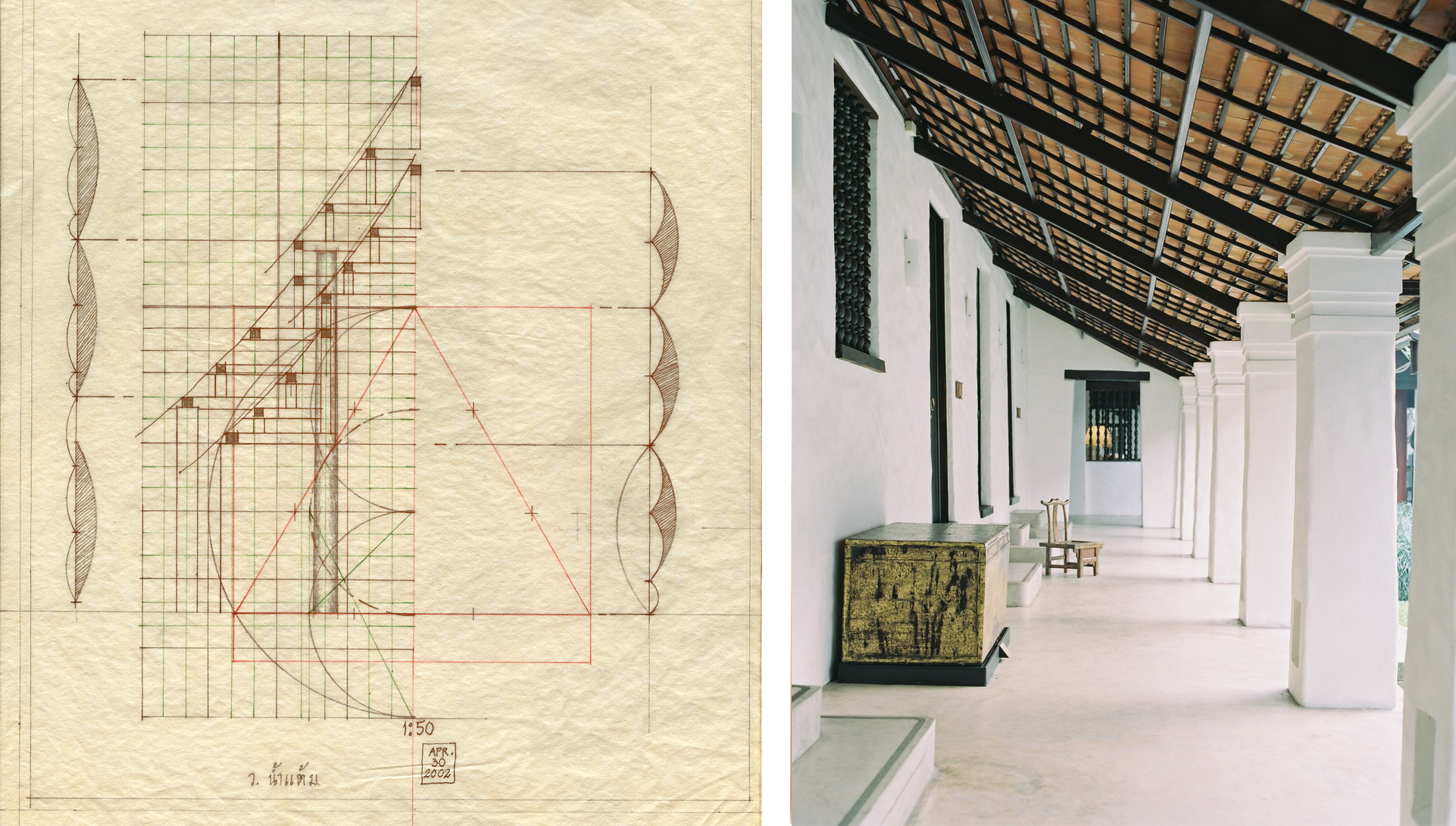
‘สัดส่วน’ (proportion) เป็นหลักสำคัญที่องอาจใช้ในการออกแบบสถาปัตยกรรมอยู่เป็นประจำ โดยสัดส่วนต่างๆ นั้นเกิดขึ้นจากการศึกษาสถาปัตยกรรมตะวันตกและตะวันออกอย่างเป็นจริงเป็นจังของเขา | ‘PROPORTION’ IS ONE OF THE SIGNIFICANT PRINCIPLES THAT SATRABHANDHU OFTEN UTILIZES IN HIS ARCHITECTURAL REPERTOIRE. ALL OF THE PROPORTIONS ARE ACHIEVED THROUGH HIS CRITICAL STUDY OF WESTERN AND ORIENTAL ARCHITECTURE
art4d: ในงานของคุณตั้งแต่ยุคแรกมาจนถึงปัจจุบัน เราจะเห็นว่ามันมีการเปลี่ยนแปลงทางความคิดหรือรูปแบบสถาปัตยกรรมมาตลอด ตั้งแต่ยุคโรงเรียนปานะพันธุ์ มามหาวิทยาลัยเกษตรศาสตร์ มาโตชิบา แล้วก็มาเป็นตึกช้าง จนมาถึงแทมมารินแล้วก็งานยุคหลังๆ มานี้ที่มันมีความเป็น traditional อยากทราบว่าในแต่ละการเปลี่ยนแปลงนั้นมันมีสาเหตุหรือจุดเปลี่ยนอะไรด้วยหรือเปล่า อิทธิพลตอนนั้นมันเปลี่ยนไปยังไง
OS: ก่อนที่ผมจะมาเชียงใหม่นี่ จริงๆ ผมว่าผมเป็นคนตามเทรนด์นะ อย่างตึกยิมเนเซียมของปานะพันธุ์นี่มันรวมตั้งแต่สถาปนิกญี่ปุ่นยัน James Sterling คือมันรวมกันเละเลย ซึ่งมันก็ทำให้เกิดความสับสน แต่พอขึ้นมาเชียงใหม่ตอนปี 1999 หลังจากทำแทมมาริน รู้สึกว่าผมจะเปลี่ยนไป งานผมสงบขึ้นเยอะเลย แล้วผมก็คิดว่ามันเป็นวิธีที่ถูกต้องแล้ว โดยเฉพาะถ้าสิ่งแวดล้อมโดยรอบมันสับสนมากๆ เรายิ่งต้องสร้างความสงบ อีกอย่างคือที่นี่มันมีหลายอย่างที่เรารู้สึกว่าต้องให้ความเคารพสถานที่ด้วย เวลาอยู่กรุงเทพฯ เราจะทำอะไรก็ได้ ยิ่งปัจจุบันนี่ยิ่งทำอะไรก็ได้เลย กรุงเทพฯ มัน beyond ทุกอย่าง
art4d: สำหรับคุณอะไรคือสถาปัตยกรรมที่ดี หรือสถาปัตยกรรมที่งาม
OS: ผมว่าแต่ละคนก็คิดไม่เหมือนกัน ผมเห็นความงาม ความมีเหตุผลของงาน traditional architecture และในอาคารที่เป็น monumental แต่สิ่งก่อสร้างปัจจุบันนี้ สำหรับผมไม่ค่อยจะมีความงาม แล้วมันจะอยู่ไม่นานด้วย คือตอนนี้เราอยู่ในยุคเสื่อม อันที่แน่ๆ เลยคือดูอย่างที่มีสถาปนิกมีชื่อบางคนที่จุดเด่นที่เขาภูมิใจมากคือการที่งานทุกชิ้นเขาไม่เหมือนกันเลย ทุกคนมีความเห็น ซึ่งนั่นมันก็เป็นความเห็นของเขา แต่ถ้ามองจากมุมนั้นงานที่เป็นต้นแบบสถาปัตยกรรมตะวันตกอย่างกรีกก็แย่ ตรงที่ถ้ามองแค่ผิวเผินอย่างคนไม่รู้จัก งานทุกชิ้นก็จะดูเหมือนกันหมดใช่ไหม ทำยังไงถึงจะให้นักศึกษาสถาปัตย์ที่เรียน 5 ปีจบ เขาได้เห็นถึงความสำคัญที่ต้องรู้ประวัติศาสตร์ล่ะ
สถาปัตยกรรมกรีกโบราณเมื่อเกือบ 3,000 ปีที่แล้ว เวลาเขาสร้างอาคาร เขาใช้วัสดุที่จะอยู่ถาวรตลอดไป เขาเชื่อในการสร้างอาคารเพื่อให้อยู่ตลอดกาล หรือ Trajan’s Market ที่กรุงโรมถือว่าเป็น shopping mall ที่เก่าแก่ที่สุดในโลก มีลีลาที่สวยงาม หลังจากเกือบ 2,000 ปีมาแล้ว ปัจจุบันมันก็ยังคงงดงามอยู่ มีคนเข้าไปดูทุกวัน ผมนึกไม่ออกว่ามีศูนย์การค้าใดในปัจจุบันที่อีก 2,000 ปีข้างหน้าจะยังตั้งอยู่และจะมีคนเข้าไปดู นึกไม่ออกเลย เราควรออกแบบอาคารเพื่อให้อยู่ได้นาน ใช้วัสดุที่ดีคงทน หาได้ในถิ่นนั้นๆ และอาคารที่ดีจะต้องสามารถปรับเปลี่ยนประโยชน์ใช้สอยที่เปลี่ยนไปตามเวลาได้ด้วย
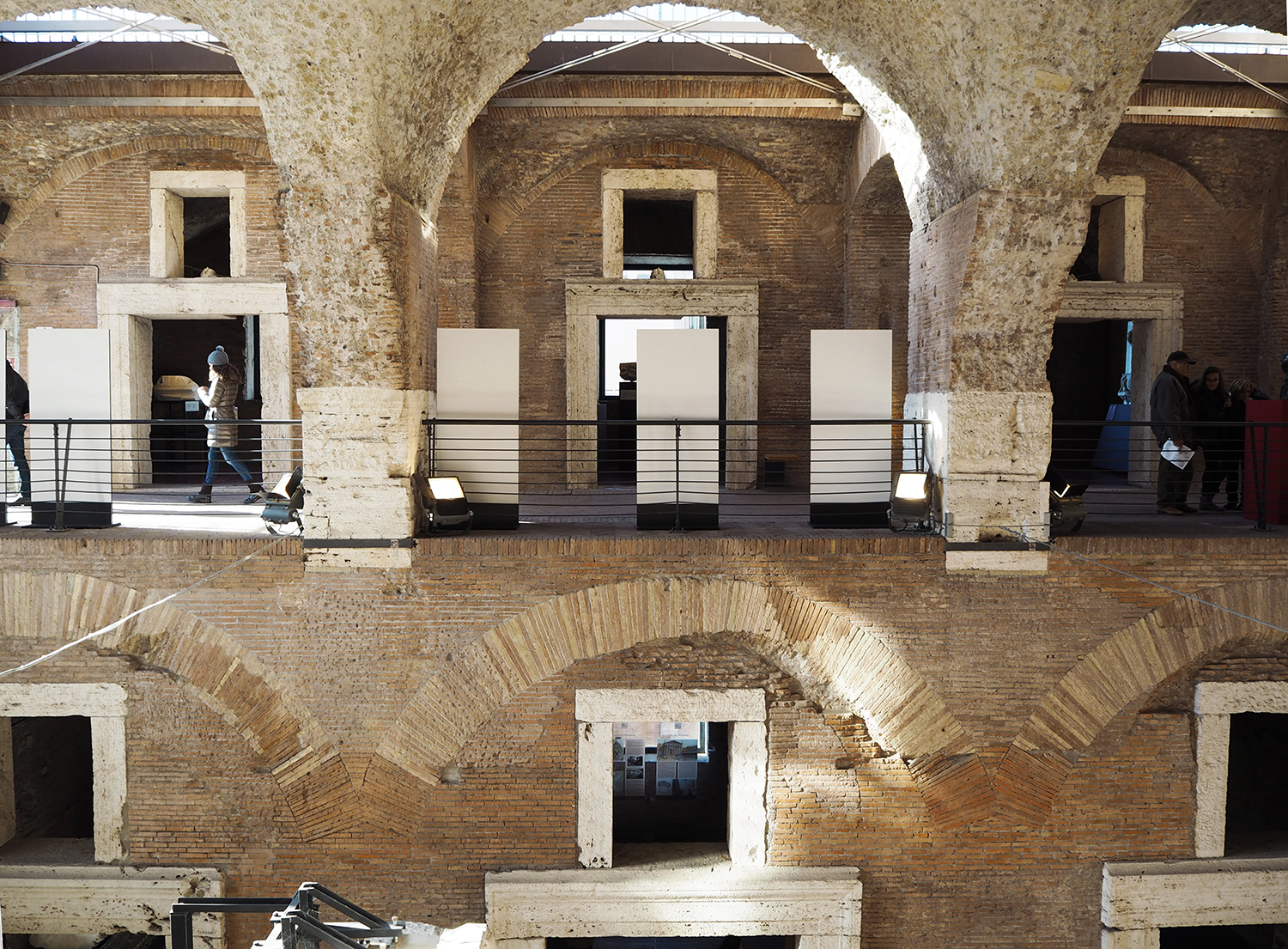
TRAJAN’S MARKET, ROME
art4d: คิดว่าสถาปัตยกรรมร่วมสมัย ณ ตอนนี้เป็นอย่างไรบ้าง
OS: อะไรคือสถาปัตยกรรมร่วมสมัย อะไรที่เรียกว่าร่วมสมัย… คือถ้าผมเห็นก็ดู ไม่เห็นก็ไม่ได้ดูเพราะผมคิดว่ามันไม่ relevant กับผมเท่าไหร่ เป็นสิ่งที่มาแล้วก็ไป แล้วยิ่งตอนนี้เขาใช้เงินสร้างกันเยอะด้วย ใช้งานเกินไป อย่างโปรเจ็คต์ที่เขาใช้เงินสร้างมิวเซียมในโรม แต่พอเสร็จแล้วก็ไม่มีเงินบริหาร ผมก็ไปดูนะตึกนั้น พวกนักท่องเที่ยวเข้าน้อยมากเลย มีแต่สถาปนิก คือสมัยนี้มันสร้างเพื่อเรียกความสนใจ ยิ่งพวกตึก high rise ต่างๆ นี่ ถ้าดูในแมกกาซีนมันถ่ายรูปเลือกมุมสวยดี แต่ไปดูจริงๆ มันไม่ใช่ คือตึกที่ดีมันต้องทำให้เกิดสภาพเมืองที่ดีด้วย
art4d: มองว่าสถาปนิกไทยสมัยนี้เป็นอย่างไรบ้าง
OS: ผมไม่มีความเห็น เอาอย่างนี้ดีกว่า ผมไม่มีความรู้พอที่จะออกความเห็น
art4d: ในสมัยนี้มีเด็กจำนวนหนึ่งเลยที่พึ่งพาคอมพิวเตอร์เยอะมาก จนทำให้วิธีการทำงานแบบเดิมไม่ว่าจะการวาดด้วยมือ หรือแม้แต่การตัดโมเดลมันเริ่มน้อยลงจนค่อยๆ หายไปจากกระบวนการออกแบบ คุณมีความเห็นยังไงกับปรากฏการณ์นี้บ้าง
OS: เขาไม่สเก็ตช์กันด้วยนะ เพราะเขาไม่คิดว่าต้องใช้มือแล้ว ผมใช้คอมพิวเตอร์ไม่เป็นเลย ผมยังชอบเขียนด้วยมือ แต่ผมว่าจากที่เราคิดในหัวแล้วใช้มือวาดหรือเขียนลงไป ความรู้สึกมัน direct กว่า คือมันทั้ง proportion แล้วก็ feeling ถ้าไปที่คอมพิวเตอร์แล้วมันขาดตอน
art4d: ถ้าจะให้แนะนำหนังสือสัก 2-3 เล่ม สำหรับให้ทั้งนักเรียนสถาปัตย์และสถาปนิกอ่าน มีเล่มไหนที่จะแนะนำบ้าง
OS: เล่มที่ผมชอบอ่านจะมี Experiencing Architecture ของ Steen Eiler Rasmussen กับ The Perfect House ของ Witold Rybczynski อย่างเล่มแรกนี่เขาสอนให้คน appreciate งานสถาปัตยกรรม ผมคิดว่า เอาแค่ที่เขาบอกว่าให้เราดูอะไรต่างๆ ไม่ว่าจะเป็นสิ่งที่เรียกว่า urban space ที่ดี หรือรายละเอียดต่างๆ ในเมือง ที่เริ่มจากที่เราไม่เห็นอะไร แล้วค่อยๆ เดินไปตามถนนในโรม แล้วจู่ๆ ก็เจอโบสถ์ทั้งๆ ที่ตอนต้นถนนนั้นเรามองไม่เห็นมัน เขาทำให้เราได้ experiencing เหมือนกับชื่อหนังสือเลย เดี๋ยวนี้ทุกมหาวิทยาลัยเขาก็จะมี Rome Course กันหมดเพราะการได้สัมผัสเป็นการเรียนรู้ที่ดี โรมเป็นเมืองที่มีความสัมพันธ์กับมนุษย์ คือเราสามารถเดินได้ระยะไกลๆ โดยที่ไม่รู้สึกว่ามันไกล เพราะว่าตลอดทางที่เดินไปเราจะพบอะไรต่ออะไรตลอด ที่เชียงใหม่ถ้าเราเดินจากวัดพระสิงห์ไปท่าแพ มันอาจจะไม่เจออะไรเลยที่เป็นประโยชน์กับความคิดเรา จนมันทำให้เราตายด้าน จนยอมรับสิ่งที่มันน่าเกลียด ซึ่งเราไม่ควรจะเป็นอย่างนั้นนะ ส่วนเล่มของ Rybczynski ผมชอบวิธีที่เขาแนะนำงานของ Palladio อ่านแล้วเพลินดี คืออ่านแล้วไม่เหมือนอ่าน Eisenman อันนั้นอ่านแล้วต้องกินยาระงับประสาท (หัวเราะ) รู้สึกปัญหาเยอะ อันนี้รู้สึกโลกจะสวยงาม
อีกสองเล่มที่อยากจะแนะนำคือ Architecture: Choice or Fate ของ Léon Krier เป็นหนังสือที่ให้ข้อคิดว่าทำไมเมืองและอาคารในประวัติศาสตร์จึงเป็นสิ่งต้องเก็บรักษาไว้ และเมื่อสถาปนิกออกแบบอาคารหรือกลุ่มอาคารเราควรเอาข้อดีของอาคารโบราณเป็นแบบอย่าง กับ In the Mood for Architecture: Tradition, Modernism and Serendipity ของ Lucien Steil โดยเฉพาะเนื้อหาใน Chapter IV, On Imitation and Originality ซึ่งเขาได้เขียนไว้เมื่อกว่า 30 ปีที่แล้ว แต่เขาเรียบเรียงให้อ่านง่ายขึ้น


art4d: How do you develop a work of architecture within a particular context?
Ong-ard Satrabhandhu: I don’t think Thailand has a definite context. When I work, I look at it just in terms of the space in this world that I create because that’s the only thing I have control over. I don’t have the power to control what is surrounding the work that I do, so I choose to turn my back on it. It isn’t exactly a good thing but it’s the only way I can find peace. Why I do this is simply because there is no other way. The context is constantly changing. The regulations that can help organize the city are not the ones that we have. I think when you build a road, the buildings have to be on the same plane, not set back to whatever range the owners wish. A beautiful city is one where the roads turn here and there, but the buildings are properly controlled and organized. Take a project I did on Yaowarat road, for example, it was perfectly fine to do a renovation but once you demolish a structure for a rebuild, then the building is forced to be set to certain meters, which is nonsense because the original range keeps the side of the road organized. Now you see new structures being set back. Architects destroy the city as much as the regulations do.
art4d: If there was a brief that required a built structure to be surrounded by nature, how would you work it out, would you enclose the structure with nature, or turn your back on it and create a new context for it?
OS: Take the residence in Mae Rim for example, I designed that project to be opened because it’s enclosed by the distant presence of the mountain. I can open a space up but there needs to be a sense of outdoor space that connects with the house. And the most important thing is the axis.
art4d: From what you’ve seen in the ancient architecture of the West and China, do you think there is any collective conclusion or root that every culture shares?
OS: There is. I think what’s really important for a building is the scale of the indoor and outdoor spaces. That is an important basic element. An outdoor space has to flow, otherwise, it can’t be a space, and it has to be enclosed by a building. This references back to the four principles of Chinese architecture: enclosure, hierarchy, axiality, and symmetry.
art4d: From your observations, are there any differences in the proportions of the compositions?
OS: There are actually. I personally like the kind of space where… like if it’s an interior space and you add columns in it, it becomes like a western church. The additional element creates this subspace and that is what Western and Chinese architecture share. It’s like when Palladio creates a room and he puts in these columns and it looks so much different from the room where there was no column at all. It’s charming in a way that I cannot explain. It’s beautiful and it has to be beautiful even when it appears as a three-dimensional object. The thing that impresses people, what they like, hate, are interested in or tired of is the quality of the space, not the physical form because space generates dynamics. Look at the plan of Barcelona Pavilion, there are only a few lines but when I saw the real thing, my heart was beating fast because the space creates such tremendous movement. You thought you could enter directly from here but you couldn’t – that’s Architectural Promenade. That’s what students should be observing and learning about rather than learning from abstract forms.
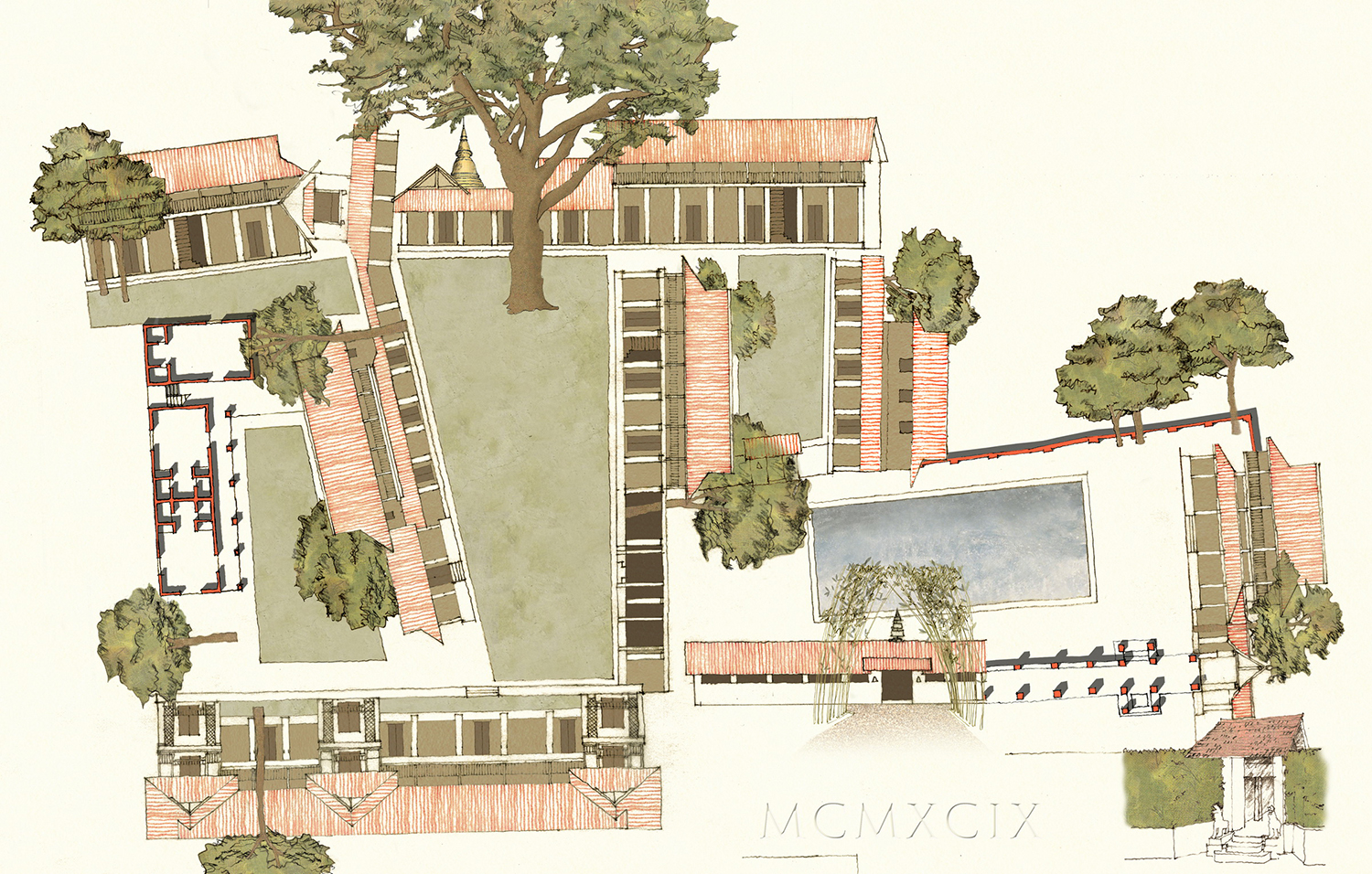
แบบของโรงแรมแทมมารีน วิลเลจ ที่มีการผสมผสานผังพื้นไว้รวมกับรูปด้านอาคาร แสดงการจัดวางอาคารและลำดับการเข้าถึงสเปซ | A DRAWING OF TAMARIND VILLAGE THAT BRINGS TOGETHER FLOOR PLANS AND ELEVATIONS TO ILLUSTRATE THE ORGANIZATION OF THE BUILDINGS AND THE SEQUENCE OF SPACES
art4d: Let’s talk about Chiang Mai. Your first project here was created in 1999 and it was Tamarind Village Hotel. Why did you decide to relocate here?
OS: I moved here in 2000 and it was more of an accident. When I was working on the hotel, I had to come here and was at the site almost every day. I ended up having to come here 2-3 times a month and each time I would spend 2-3 days but I still had to discuss the project with the architect who was based here. The reason I had to be at the site all the time was because there wasn’t a precise plan but rather a very rough one so I was required to be on site pretty much the whole time. Once the building was completed, they still didn’t know how to connect what to where because we worked on site and I talked with the builders on a daily basis about what I wanted them to do. The good thing about this method of working is that the work looks very natural, like one of those structures built by the locals. But the problem was that there was only one person who was the leader of the builders and he was the only who knew what to do, and the rest didn’t really know the drill. If he got sick, the work had to be put on hold. Even I couldn’t do the job because I didn’t have knowledge of the construction methods. That’s my weak point. When I was at Vicenza, they said that the columns that Palladio sculpted were more delicate than others. I, on the other hand, don’t have the kind of skills that can lead a construction operation. If we were to stick with what Vitruvius says, that architects need to know how to do these things, there wouldn’t be anyone who would be qualified to be an architect. To me, everything has an origin. When people see my work, I tell them about the origins of certain elements or compositions because I want them to know of them. I haven’t thought of anything original since I was born. People who can come up with something original have to be extremely talented. Just to design a building that people won’t reprimand or refuse to go inside of is already hard enough.
art4d: Since the almost 20 years that you first moved to Chiang Mai, how much has the city changed in your view as the new developments come pouring in with new economic possibilities while gentrification is, at the same time, destroying the city?
OS: Everyone is thirsting for money and that’s why things have changed to be the way they are. People do things because they can make money not because they want to create something worthwhile or aesthetically valuable. They want to stand out but they don’t have the core values. That is why the city is being destroyed. It’s a fact. It’s like how mobile phones have become such an integral part of our lives now. It’s progress, but the culture, the art and aesthetics used to be entirely different. The city is developed but it has developed in other aspects.
art4d: Was Tamarind Village Hotel the first project where you incorporated traditional elements in as a part of the design?
OS: It was my first project. The city’s canal wasn’t surrounded by hotels like it is now because most people would think of a resort far from the city center, surrounded by nature when they thought about doing a hotel business here. The special element I created with Tamarind was inspired by the alleyways in European cities and the way that they lead you into these amazing spaces. I personally think that putting a parking space in front of your establishment
is just like you’re standing naked. It’s obscene. When I was working on Rin Kham project on a corner of Nimmanhaemin Road, the owner told me that he wanted to have the building set back and put the parking space at the front. I told him I didn’t agree with his idea and would propose my concept. If he didn’t like it, he could pay me the agreed amount of money, but if he agreed to do what I said, I would continue with the project. I said that because I knew what I was going to do with the project wouldn’t be what he wanted it to be. It turned out that he liked my concept of having public space hidden inside the complex for people who don’t drive. The building is situated right next to the public road with some architectural features allowing for one to see from the street what’s going on inside.
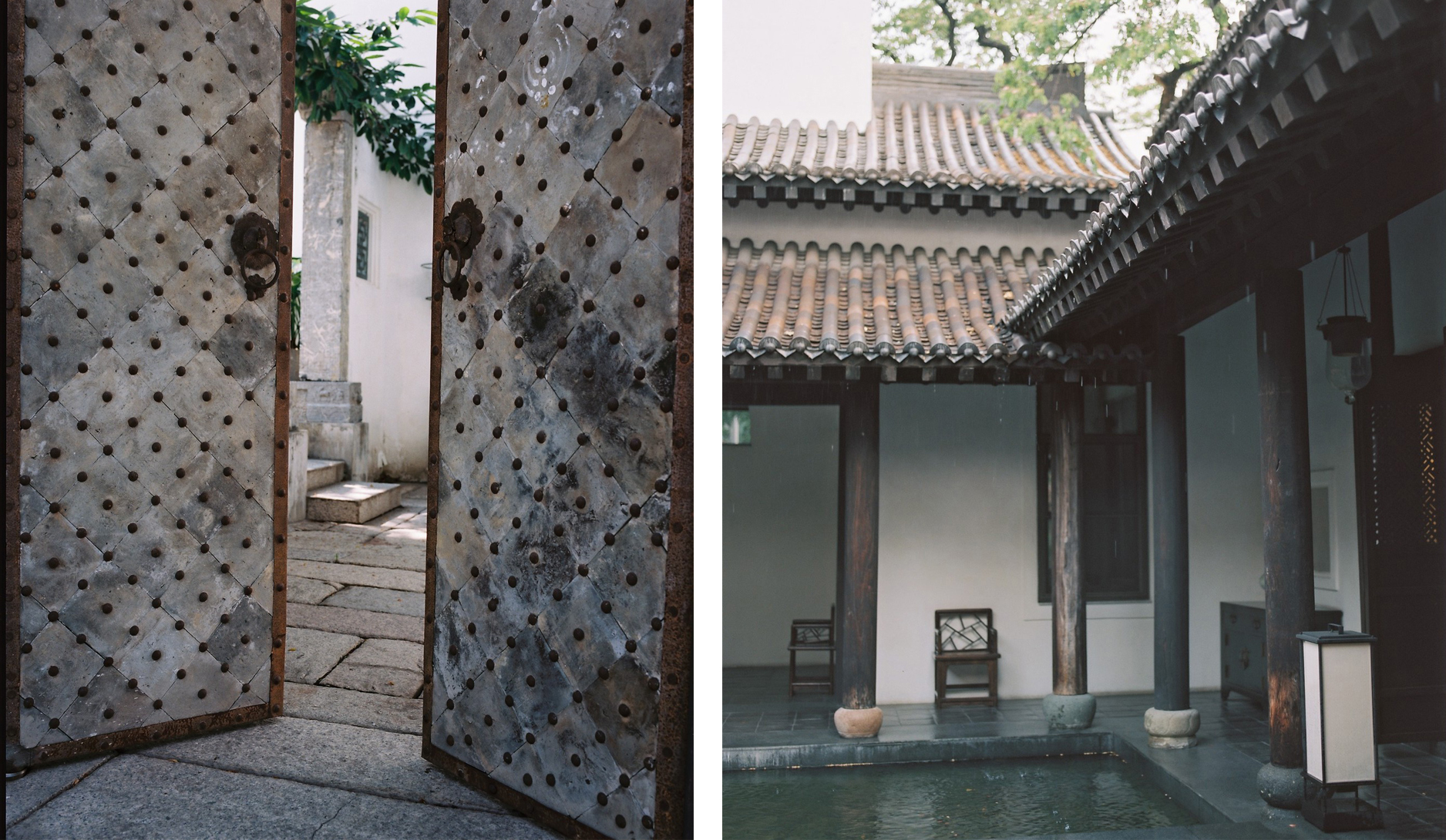
‘การเคลื่อนผ่านสเปซ’ (movement through space) เป็นอีกหนึ่งองค์ประกอบที่พบได้ในผลงานขององอาจ ตั้งแต่เริ่มต้นทำงานมาจนถึงปัจจุบัน โดยหลักการดังกล่าวอาจเรียกได้อีกชื่อว่า Architectural Promenade ซึ่งเป็นแนวคิดเรื่องลำดับการเข้าถึงสเปซที่พบได้มากในผลงานของ Le Corbusier | ‘MOVEMENT THROUGH SPACE’ IS ANOTHER ELEMENT THAT CAN BE FOUND IN THE WORKS OF SATRABHANDHU SINCE THE BEGINNING OF HIS PRACTICE TO THIS DAY. THIS PRINCIPLE IS ALSO WIDELY KNOWN AS ‘ARCHITECTURAL PROMENADE’ WHICH IS A KEY IDEA BEHIND THE MOVEMENT THROUGH THE SEQUENCE OF SPACES IN MUCH OF LE CORBUSIER’S WORKS
art4d: What is your favorite work that you have created in your career?
OS: I don’t have one. Every project has its flaws. I used to think that if I had the money, I would hire architects to do everything for me so that I could finally be happy (laugh). But right now, all the architects I wanted to work for me are dead and I didn’t have enough money to hire them anyway. There were a lot of problems and I have never felt completely satisfied with what I have done.
art4d: From past to present, your ideas and architectural style have been very fluid. From Panabhandhu School to the Kasetsart University project, Toshiba Headquarters, Elephant Building, Tamarind Hotel and your most recent works which contain certain traditional elements, are there causes or influences behind these changes?
OS: Before I moved to Chiang Mai, I was very influenced by trends. The gymnasium building of Panabhandhu School was a combination of everything from Japanese architects’ works all the way to James Sterling’s. It was like putting everything together into a mix, and it’s confusing. When I came up here in 1999, after Tamarind, I felt different. My works are more peaceful now and I think that’s the right way to work because the more confusing the environment around you, the more peace you need. The other thing is that there are many things that I feel like I need to consider and places I have to respect. It isn’t like in Bangkok where we could do anything. That city is beyond everything.
art4d: For you, what is good or beautiful architecture?
OS: The answer is very subjective. I’ve seen beauty and rationality in traditional architecture and monumental buildings, but contemporary built structures don’t possess that kind of aesthetics and they don’t last very long. We are in decline. Certainly, there are reputable architects who are proud of the way that none of their works are identical. I mean, everyone is entitled to an opinion. But if we were to look at it from that aspect, the very origin of Western architecture (like Greek architecture) would be far from great because those who don’t know it very well would say that everything looks the same. So how can we make architecture students acknowledge the importance of history during the five years they spend at architecture schools? That’s the question.
The architecture of ancient Greece created 3,000 years ago was built using long-lasting materials because they believed in building permanent works of architecture. Look at some of the oldest shopping malls in the world such as the Trajan’s Market in Rome. It has been magnificent for over 2,000 years and people still pay visits to it to this day. I can’t think of any other shopping malls that could survive this long. We should design built structures to be permanent and invulnerable through the use of local materials that last a long time. What makes something a good building is how flexible it is to change and its ability to adjust its functionality throughout time.
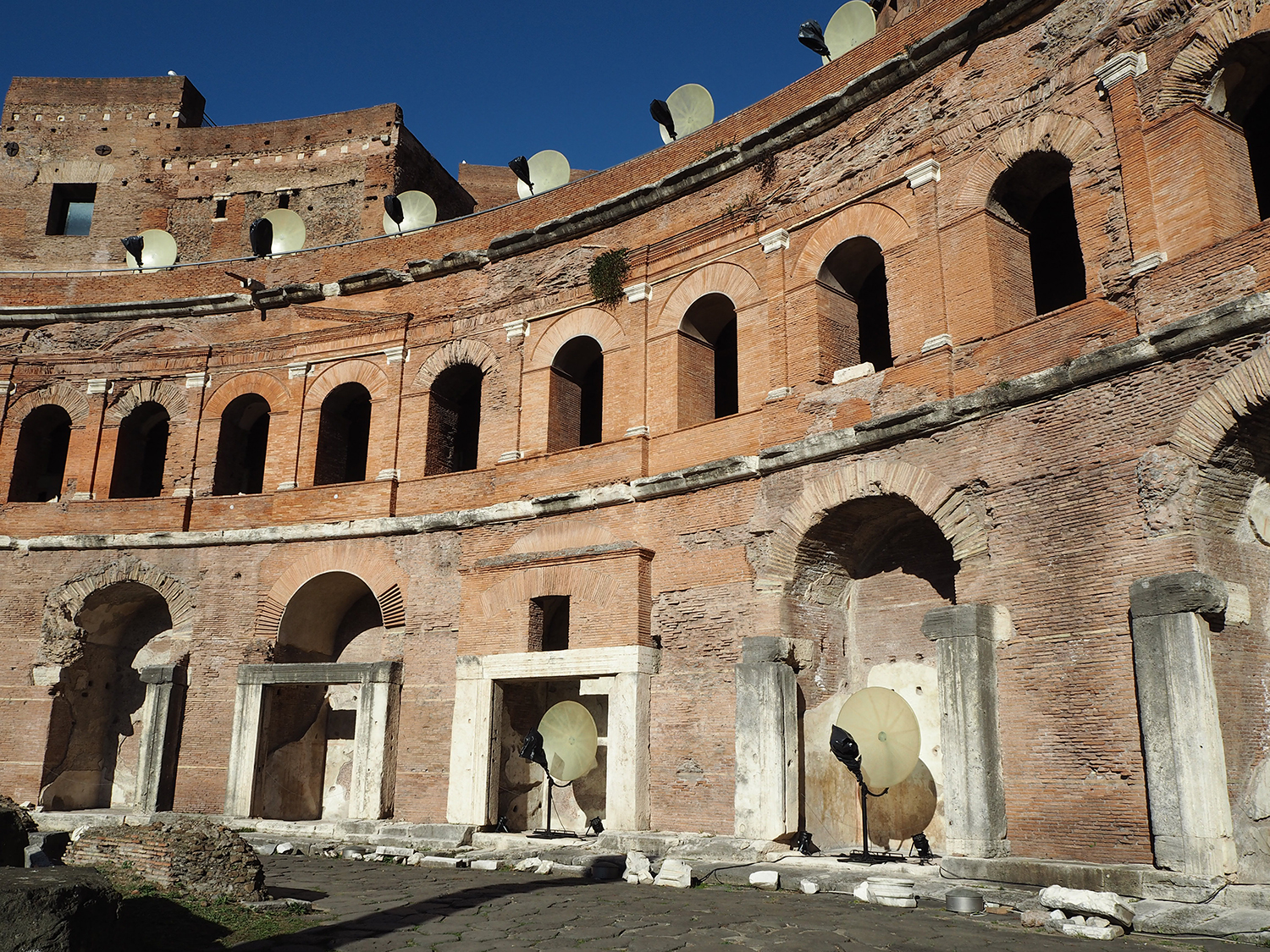
TRAJAN’S MARKET, ROME
art4d: What are your views of contemporary architecture?
OS: What exactly is contemporary architecture? What do you define as contemporary? If I saw a work of one I would look, but if I didn’t, it wouldn’t be something I would contemplate because I don’t think it’s relevant to me. It’s something that comes and goes. With the money being invested in the making of these new structures, everything seems so exaggerated. Like that museum project in Rome where the building is done and everything but they don’t have the money to run it. I saw that building and there were very few tourists with most of the visitors being architects. Buildings are created to attract people’s interests, especially all the high-rise structures. I mean you see them in pictures in magazines and they look beautiful but the real thing isn’t exactly as you see in the photos. A good building is the kind of building that helps improve a city’s urban condition.
art4d: What do you think about Thai architects nowadays?
OS: No comment. Let’s just say that I’m not informed enough to make any comment.
art4d: The younger generation of architects relies so much on computers that hand-sketching or models are starting to disappear from the design process, what is your opinion on this phenomenon?
OS: They also don’t sketch and they don’t feel the need to use their hands. But it is just that I don’t know how to use a computer at all and I still love using my hands. I think when you sketch the ideas you have in your head into drawings using your hands, the feelings and proportions are more directly transformed. The computer disrupts this transition for me.
art4d: If we ask you to recommend a couple of books for architecture students and architects to read, what books would you recommend?
OS: My personal favorites are Steen Eiler Rasmussen’s ‘Experiencing Architecture’ and Witold Rybczynski’s ‘The Perfect House.’ The first one teaches people to appreciate architecture and I think that just because of the way Rasmussen tells you to look at things from a good urban space or in terms of other details in a city, it’s like you start walking down a street in Rome and suddenly you come across this church that you didn’t see when you first turned into the street. It’s a way we experience architecture, just like the name of the book. Universities today have courses on Rome because experiencing something is a perfect way of learning. Rome is a city that has this incredibly close connection with humans. You can walk a long distance without feeling that it’s far because you are constantly experiencing something but if you walk from Wat Phra Singh Temple to Tha Phae Gate in Chiang Mai, you probably don’t come across anything that will be beneficial to your idea. You become so indifferent that you succumb to the ugliness, and it shouldn’t be that way. I like Rybczynski because I happen to like the way the book introduces Palladio. That is very fun to read. It isn’t like when you read Eisenman’s writings. You need a sedative for that (laugh). Too many problems. Rybczynski makes you feel like the world is beautiful.
Another two books that I would like to recommend are Léon Krier’s ‘Architecture: Choice or Fate’ and Lucien Steil’s ‘In the Mood for Architecture: Tradition, Modernism and Serendipity.’ The first one gives us some idea of why preserving historical cities and buildings is vital and what features of historical architecture we should utilize when it comes to designing buildings or a group of buildings. The latter one, especially its Chapter IV: On Imitation and Originality, is also great for it has easy-to-read content although it was written 30 years ago.

